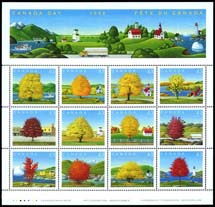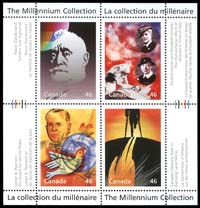
|
Elizabethan II Study Group Journal: The Corgi Times Glossary |
M | |||||||||||||||||||||||||||||
| Magnifying glass - an essential tool used by serious collectors, as it enables the critical examination of the fine detail of a design, or the quality of a specimen. |
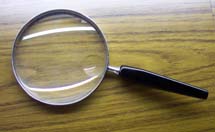 Magnifying glass |
||||||||||||||||||||||||||||
| 'Major' varieties - variations of importance, either in type, colour, design, perforation, phosphor tagging, or format, from the basic design, and which the serious collector would feel s/he must include in his/her collection. | |||||||||||||||||||||||||||||
| Maple Leaf - Canada's national emblem, used extensively on Canadian stamps. |
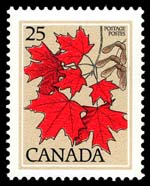 Maple Leaf
|
||||||||||||||||||||||||||||
|
Maple Leaf perforation -
security
feature incorporated into
perforations. Canada's Maple Leaf perforation issues include:
|
 Maple Leaf perforation |
||||||||||||||||||||||||||||
| Maple Leaves - journal of the Canadian Philatelic Society of Great Britain. |
 Maple Leaves |
||||||||||||||||||||||||||||
| Marcophily - postmark collecting. | |||||||||||||||||||||||||||||
| Margin -
(1) the selvedge surrounding the stamps in a sheet, often carrying inscriptions of various kinds, such as the imprint and authority off the printer or Government printing establishment; instructions and notes for separation or division into specified values and amounts; arrows and other marks for a similar purpose; control letters and/or figures; cylinder numbers; perforating alignment holes, and details that help in identifying the form of perforator used, and other interesting marks that normally appear there only. (2) the unprinted area between stamps in a sheet or what is left after stamps are separated (ie. the borders of individual stamps). The stamp margins in an imperforate specimen are most important, and should not under any circumstances be re-cut, for the wider the margin, within reason, the more obvious is the authenticity of the specimen and the more value to the collector. All four margins should be good and clear of the design. |
|||||||||||||||||||||||||||||
| Maximum card - pictorial postal cards bearing (a) a relevant picture or design, (b) a stamp related to the subject on the card, and (c) a postmark relevant to both postage, postal card, and event, personage, place, or other subject thereon. | |||||||||||||||||||||||||||||
| Meter - Government permit of specified face value applied as a prepaid postmark in lieu of stamps. |
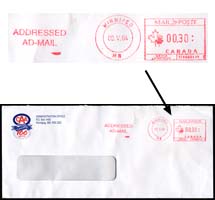 Meter; Metered mail |
||||||||||||||||||||||||||||
| Metered mail - mail franked by a postage meter, a device that automatically imprints the proper postal rate with a distinctive imprint in the upper right-hand area of the envelope. | |||||||||||||||||||||||||||||
| Millennium Collection - collection of stamps issued by Canada Post in 1999 to mark the new Millennium.
Initially the set of 68 stamps were issued in a unique page format created exclusively for The Millennium Collection hardcover book. Collector outcry and the lack of recognition by the Scott Publishing Company for inclusion in their standard stamp catalogue resulted in the stamps being re-issued in 17 miniature panes of 4 stamps each. |
 Millennium Collection
|
||||||||||||||||||||||||||||
| Millimetres - one thousandth of a metre. Twenty millimetres have been adopted as the international standard of measurement to gauge stamp
perforations. That is, the number of perfs to 20mm being quoted as the perf number.
All-over measurements of a stamp, the height, length, and spacing, and all other vital philatelic measurements are usually given in millimetres. There are 25.4mm in one inch. |
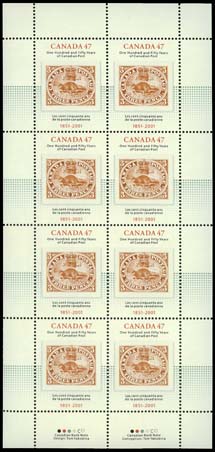 Miniature sheet |
||||||||||||||||||||||||||||
| Miniature sheet - a smaller-than-normal pane of stamps issued only in that form or in addition to full panes. | |||||||||||||||||||||||||||||
| Minor varieties - as the name implies, slight variations from the normal stamp, of interest to specialists but not usually of sufficient importance to be listed in general catalogues. | |||||||||||||||||||||||||||||
| Mint -
personally, I feel that a mint stamp is one that is in the same state as issued by a post office: unused, undamaged and with full original gum (if so issued with gum). Over time, handling, light and atmospheric conditions affect the mint state of stamps. However, other collectors may feel that a mint stamp is simply one that is not used. As such, an "unused" stamp with no gum may be considered mint by others. See Used. |
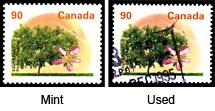 |
||||||||||||||||||||||||||||
| Mirror image - negative or reverse impression. An offset. | |||||||||||||||||||||||||||||
| Missing colour - major error where one (or more colours) are missing due to a problem while printing stamps. |
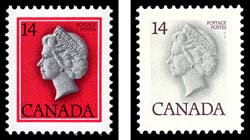 Missing colour error (right stamp is missing red background) |
||||||||||||||||||||||||||||
| Mission mixture - the lowest grade of stamp mixture, containing unsorted but primarily common, stamps on paper, as purchased from missions or other institutions.
See Kiloware. |
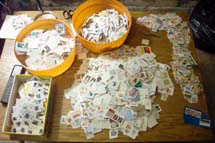 Mission mixture |
||||||||||||||||||||||||||||
| Mixed postage - covers franked with stamps of two or more postal administrations, or countries; or different regimes of the same country; or with originating country's postage stamps and ad with country of destination's postage dues. | |||||||||||||||||||||||||||||
| MLOCR - acronym for Multi-Line Optical Character Readers. Starting 1990, replaced the older
OCR equipment. Could not only read the
postal code but also the address, which it compared with the postal code and was able to code 32,000 letters per hour.
See also Jet Spray Printer. |
 MLOCR equipment |
||||||||||||||||||||||||||||
| Money order - | |||||||||||||||||||||||||||||
| Monochrome - one colour.
See Bicolour, Multicolour (below). |
 Monochrome |
||||||||||||||||||||||||||||
| MOON - acronym for Money Order Office Number.
Starting in 1923 each Canadian post office was
assigned a MOON to simplify the accounting process. Accounting Offices were assigned a 4-digit number; Non-accounting Offices and Postal Agencies a 5-digit number. Numbers were allotted by Province and then alphabetically within the province. MOONs first appeared on precancelled stamps and post office forms, and then on cancels in the 1950's. The MOON cancel replaced the MOTO cancel (see below). MOON hammers became obsolete on March 30, 1973 when cancels bearing the six-digit Post Office Computer Organization Number (POCON) system were introduced. |
 MOON cancel |
||||||||||||||||||||||||||||
| MOTO - acronym for Money Order Transfer Office. |
 MOTO cancel |
||||||||||||||||||||||||||||
| Mounts - acetate holders, clear on the front and with some sort of adhesive on the back. Mounts hold stamps with pressure and are affixed to an album page. Collectors use mounts to mount stamps or covers. | |||||||||||||||||||||||||||||
| Multicolour - more than two colours.
See Bicolour. |
 Multicolour |
||||||||||||||||||||||||||||
| Multiple - an unseparated unit of stamps including at least two stamps, but fewer than the number included in a full
pane.
Two or more unseparated stamps of different designs are called se-tenant. Joined stamps printed upside down in relation to each other are called tÍte-bÍche. |
|||||||||||||||||||||||||||||
|
© 2001-2017, 2018 Website design by: Adminware Corporation. For information or questions regarding this website, please contact Robin Harris |
